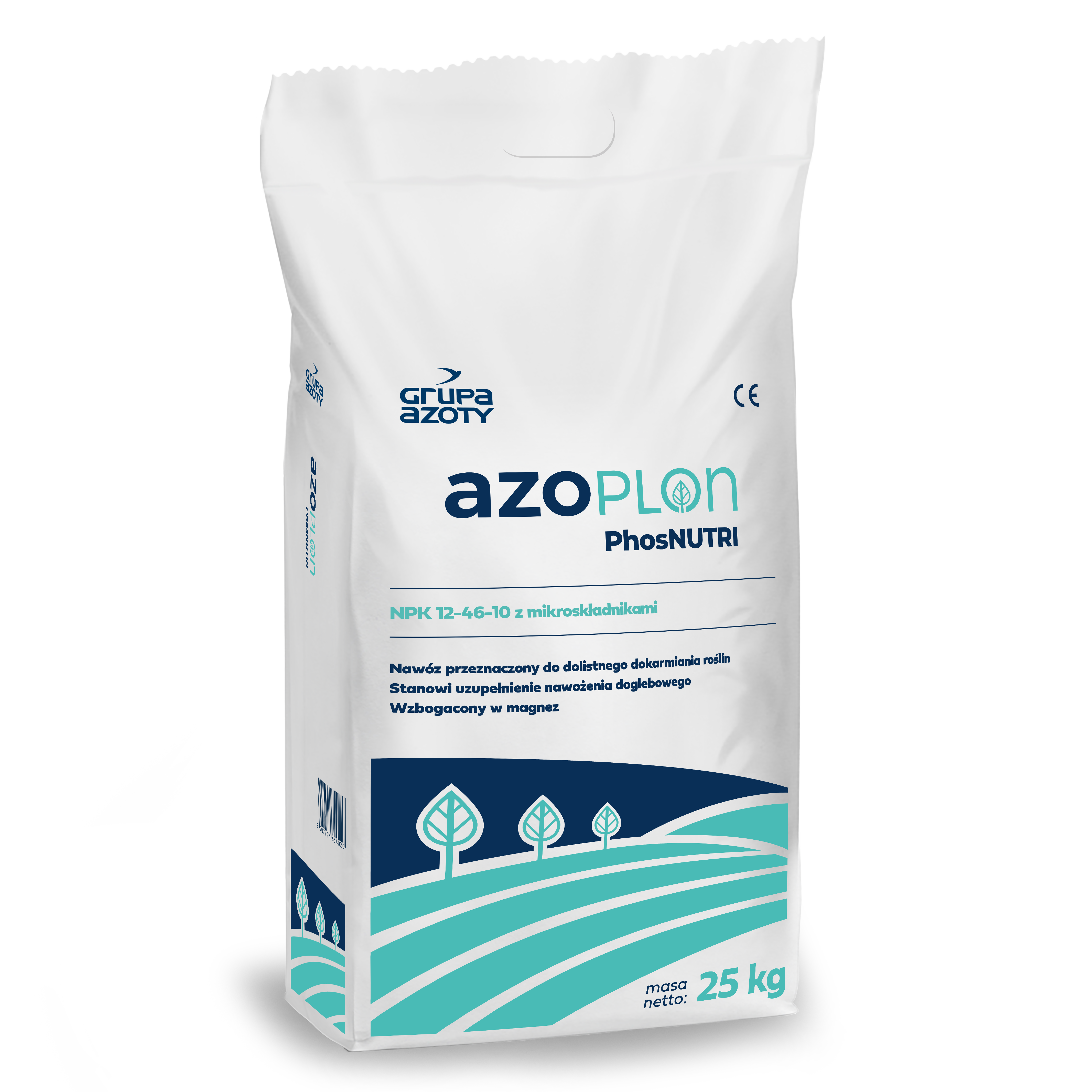
AZOPLON NUTRI 12-46-10 + micro is a multi-component, completely water-soluble, chlorine-free crystalline fertilizer with increased phosphorus content enriched with a complete set of EDTA chelate micronutrents. A fertilizer for foliar feeding of most crops, orchards and vegetables. Recommended feeding od most crops, orchards and vegetables. Recommended for use during periods of increased demand for posphorus, mainly in the stages of intensive growth and development. Foliar application of phosphorus, the fertilizer ensures effective development of the root system, dynamic flowering, increased resistance to adverse environmental factors and improved colouring of the fruit.
For foliar application, it is recommended to spray with a solution of appropriate concentration. Foliar treatments dhould not be performed during hot and sunny weather, at extremely low or high temperatures, and on plants with wilting symptoms.
| Nutrients | % (m/m) |
| Total nitrogen (N) | 12 |
| Nitrate nitrogen (N-NO3) | 3 |
| Ammonia nitrogen (N-NH4) | 9 |
| Phosphorus pentoxide (P2O5) | 46 |
| Potassium oxide (K2O) | 10 |
| Boron (B) | 0.02 |
| Copper (Cu) (EDTA) | 0.05 |
| Iron (Fe) (EDTA) | 0.05 |
| Manganese (Mn) (EDTA) | 0.01 |
| Molybdenum (Mo) | 0.001 |
| Zinc (Zn) (EDTA) | 0.03 |




The current practice of micronutrient fertilization is largely based on foliar nutrition. The quantity of microelements used by crops is usually low and ranges from 1% to 20%. The advantage of AZOPLON NUTRI fertilizers is that they are enriched with a complete set of EDTA chelated micronutrients. Chelates exhibit good solubility and very high availability for plants. Their particles molecules are chemically inert, which is why they do not regress in foliar vascular tissue. Plants can take up micronutrients from chelates not only as a released ion, but also as a chelate molecule.

| Crop | Application time | Application rate (kg/ha) | Recommended number ofapplications | Recommended quantity of spray liquid (L/ha) |
| FIELD CROPS | ||||
| Cereals | 3-6 unfolded (autumn), tillerin, beginning of stem elongation | 2 – 4 | 1 – 3 | 200 – 300 |
| Oilseed rape | 4-8 leaves unfolded, inflorescence emergence, early pod development | 2 – 4 | 1 – 3 | 200 – 300 |
| Maize | 3-6 leaves unfolded, 8-10 leaves unfolded | 2 – 4 | 1 – 2 | 200 – 300 |
| Sunflower | 4-6 leaves unfolded, beginning of stem elongation | 2 – 4 | 1 | 200 – 300 |
| Potato | 3-6 leaves on main stem unfolded, tuber initiationSkin set complete | 2 – 4 | 1 – 3 | 200 – 300 |
| Soybean | Early formation of side shoots, inflorescence emergence | 2 – 4 | 1 | 200 – 300 |
| Flax | 3-Beginning of stem elongation | 2 – 4 | 1 | 200 – 300 |
| Other | In case of deficiency | 2 – 4 | 2 – 3 every 10 – 14 days | 200 – 300 |
| ORCHARDS | ||||
| Stone-fruit trees: sour cherry, cherry, plum, peach, apricot | After flowering,maturity of fruit | 2 – 4 | 2 – 5 | 500 – 800 |
| Pome-fruit trees: apple tree, pear tree | After flowering,maturity of fruit | 2 – 4 | 2 – 5 | 500 – 800 |
| Berry plants: raspberry, blackberry, currant, blueberry, strawberry | After flowering,maturity of fruit | 2 – 4 | 2 – 5 | 500 – 800 |
| VEGETABLES | ||||
| Solanaceous vegetables: tomato, pepper, eggplant | 3-7 true leaves unfolded | 2 – 4 | 1 | 300 – 500 |
| Fruit development | 2 – 4 | 1 | 300 – 500 | |
| Legumes: peas, beans | First flower buds visible | 2 – 4 | 1 | 300 – 500 |
| Root vegetables: carrot, parsley, celery, beetroot | 2-3 true leaves unfolded | 2 – 4 | 1 | 300 – 500 |
| Leafy vegetables: headed cabbage, cauliflower, broccoli,kohlrabi, radish, kale | When plants take root | 2 – 4 | 1 | 300 - 500 |
| Vegetable seedling | 2 leaves unfolded | 2 – 4 | 1 | 0.2 – 0.3 |
| Nurseries of fruit plants | After winter | 2 – 4 | 1 – 2 times every 7 – 14 days | 0.2 – 0.3 |
| During winter preparation | 2 – 4 | 1 | 0.2 – 0.3 | |
| Nurseries of ornamental annual plants | When plants are rooted | 2 – 4 | 1 – 3 times every 7 – 14 days | 0.2 – 0.3 |
| Nurseries of perennial annual plants | After winter | 2 – 4 | 2 times every 7 – 14 days | 0.2 – 0.3 |
| During winter preparation | 2 – 4 | 1 | 0.2 – 0.3 | |
| FERTIGATION | ||||
| Vegetable seedling | 0.3 – 1 kg per 1000 l of water | 0.03 – 0.1 | ||
| Orchards | 0.3 – 1 kg per 1000 l of water | 0.03 – 0.1 | ||
| Berry plants | 0.3 – 1 kg per 1000 l of water | 0.03 – 0.1 | ||
| Orchard plants | 0.3 – 1 kg per 1000 l of water | 0.03 – 0.1 | ||
| Nurseries of annual ornamental plants | 0.3 – 1 kg per 1000 l of water | 0.03 – 0.1 | ||
| Nurseries of perennial ornamental plants | 0.3 – 1 kg per 1000 l of water | 0.03 – 0.1 | ||
